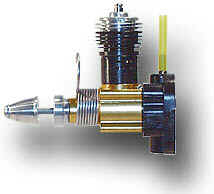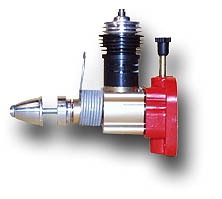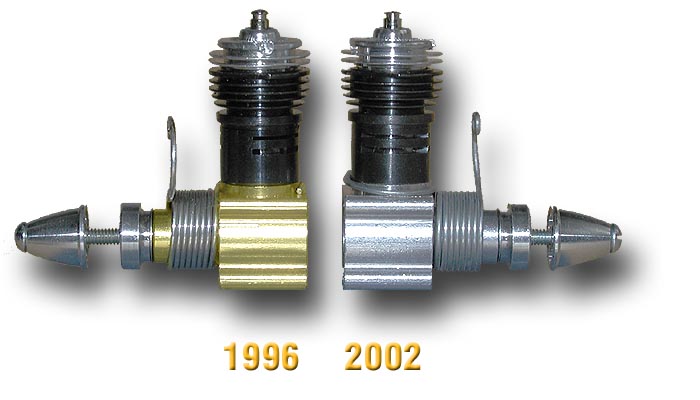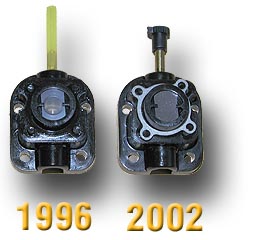|
|
 |
Killer Bee .049 (0.8
cm³)
Manufactured in 1996(?) (#340)
Advertised as a high performance competition
engine, this engine is also available with a displacement of .051 cubic
inches. The cylinder has the double slotted exhaust ports of the Texaco
and Babe Bee. The needle extension of this run of Killer Bees was made
from a piece of plastic tube. This was lightweight, cheap and reduced
vibration loads on the needle thread. |
 |
Killer Bee .051 (0.8
cm³)
Manufactured in 1997 (#360)
The larger brother of the .049 Killer Bee came
also without a mesh screen on the intake to improve performance. Both
Killer Bees have the old style spring starter, which completely disengages
to avoid friction losses. The two models differ in cylinder/piston and
back plate only. |
 |
 |
The two .049
engines shown above are both sold as under the name Killer Bee. Careful
inspections shows some differences, though.
Both engines have a sub induction cylinder, which
means that the upper slow works as an exhaust slot and the lower slots are
open at top dead center to draw some cool air into the crankcase. So the
fuel air mixture coming through the carburetor (with narrow passages and
associated pressure loss) can be rich and additional fresh air is sucked
in through the open slots which have a lower flow resistance. This is why
sub induction engines do not work well with a muffler or inside a cowling
- they start to breath their own exhaust gases.
The initial production of the Killer Bee used
gold anodized crankcase and a plastic needle extension whereas the later
models came with a plain anodized crankcase and the standard needle valve
having a black plastic cap.
Another difference is the material of the reed
valve: the older engine has a transparent plastic reed while the later
engine has a steel reed valve. In both cases the plastic reed retainer is
used.
|
 |
The main difference
between the two engines can be seen here. The early engine has a
crankshaft with a completely different web style. It has been cut to
improve the balancing and the crank pin has been drilled to remove
unnecessary weight. Additionally the piston has been made thinner and thus
lighter than a standard piston.
The later Estes engine came with a standard Babe
Bee type crankshaft without these improvements. I have not checked the
piston, but I doubt whether it includes the improvements. So it seems more
close to a basic Babe Bee with a sub induction cylinder and a different
propeller drive washer and spring starter.
|
Last modification of this page:
21.05.18

[Back to Home
Page] Suggestions? Corrections? Remarks? e-mail:
Martin Hepperle.
Due to the increasing amount of SPAM mail, I have
to change this e-Mail address regularly. You will always find the latest version
in the footer of all my pages.
It might take some time until you receive an answer
and in some cases you may even receive no answer at all. I apologize for this, but
my spare time is limited. If you have not lost patience, you might want to send
me a copy of your e-mail after a month or so.
This is a privately owned, non-profit page of purely educational purpose.
Any statements may be incorrect and unsuitable for practical usage. I cannot take
any responsibility for actions you perform based on data, assumptions, calculations
etc. taken from this web page.
© 1996-2018 Martin Hepperle
You may use the data given in this document for your personal use. If you use this
document for a publication, you have to cite the source. A publication of a recompilation
of the given material is not allowed, if the resulting product is sold for more
than the production costs.
This document may accidentally refer to trade names and trademarks, which are owned by national or international companies, but which are unknown by me. Their rights are fully recognized and these companies are kindly asked to inform me if they do not wish their names to be used at all or to be used in a different way.
This document
is part of a frame set and can be found by navigating from the entry point at the
Web site http://www.MH-AeroTools.de/.
Impressum
Datenschutz




